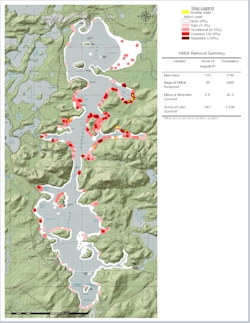|
|
|
| •
|
Management MethodsManagement encompasses those steps that a lake organization will take to deal with infestations ranging from recent discovery to established areas that have been in the lake for some time. No matter where an organization is at in the process, it’s clear that if a recent infestation can be isolated and dealt with before it has a chance to spread, the lake stands an improved chance of not having to deal with a nuisance growth. Most all of the management techniques considered by a lake association are required by the DNR to be preceded by a detailed Lake Study and a Plant Survey to understand the mappings and densities of the native vegetation. It’s important to know where you are treating and the chemistry impact to the lake. HerbicidesThis is clearly one of the most popular methods today for lake organizations to manage infestations that have grown. There are several popular herbicides on the market including Endothall (Aquathol K); 2,4-D (Sonar); and Floridone solutions. Once the plant surveys are conducted and a permit approved by the DNR for treatment (typically no more than 14% of a lakes vegetation at a time in Minnesota) then a licensed applicator utilizes GPS technology and applies the chosen herbicide. There is an improvement to water quality with removal of CLP from a lake since it will not contribute massive amounts of phosphorus to the water in July. In one effort, the City of Plymouth and Three Rivers Park District expended over $3 million dollars in the course of two years to treat Medicine Lake for Curly Pondweed. The annual maintenance budget for this project is $250,000. In another effort, Cleary Lake’s CLP grew from 30% coverage in April to 90% coverage of the entire lake by June. After 3 years of whole lake treatments with Endothall by the Army Corps of Engineers, it was still not eradicated. HarvestingThis entails powered mechanical harvesters reaching down into dense milfoil mats to cut navigable swaths through the lake. Although only 50% may be harvested without a variance, there is short term relief for residents in the use of this technique and it does not introduce herbicides into the lake or the water table. It also has a slight benefit in recycling the nutrient rich milfoil as compost. This is offset by harvester costs, necessary lake management plans/permits, disruption of native as well as invasive vegetation, and the fact that many fragments are turned loose in the water to re-establish i.e. new colonies of Eurasian Milfoil later. Investments in harvesting, treatments, and intern monitoring of landings by the LMCD are being made to manage aquatic invasive species (AIS) in Lake Minnetonka. Clam Lake in Siren has had to resort to harvesting as a means of dealing with invasives on a relatively shallow water lake. Other MethodsMilfoil Weevils, Euhrychiopsis lecontei, have met with some limited success in situations where they are utilized and they love to consume Eurasian as well as (native) Northern Milfoil. Their introduction is carefully controlled by state DNR agencies. Their cost and presence at the bottom of the food chain for some fish unfortunately don’t make this as practical choice for many lakes. Removal by hand. The painstaking effort of diving and bagging Milfoil infestations is clearly the superior ecological solution, but requires workers to correctly distinguish Eurasian Water Milfoil from other aquatics. It is clearly labor intensive as well. As can be seen on the map to the left, the Milfoil covered 46 miles of shoreline. There are No Management Solutions for Zebra Mussels for infested lakes. |
CostsBefore you can treat your lake, there are required planning and surveying costs for efforts that must be in place. Lake Management Plan Often required, the first step in a course of management is the development of a Lake Management Plan. The cost of this analysis is not inexpensive with some studies ranging up to $50,000 (e.g. Beaver Dam Lake, Cumberland, WI). This is normally only allowed to be performed by qualified consultants. Aquatic Plant Surveys Aquatic Plant Surveys are required to identify at a given point in time the mappings of native vegetation versus infestations will cost from $10,000-$20,000. Herbicide Treatment At a cost of $280-$500/acre putting 100-150 lbs per acre of herbicide into a treated area. The total cost for a 300 acre lake treatment program can quickly run quite expensive. Harvesters The capital costs are $90,000 to $120,000 for a new harvester plus labor costs to operate the equipment on the lake. Removal by Hand The cost to collect 1809 bags of milfoil in one year required 1146 man-days and cost Saranac Lake, NY $1.5 million dollars.
Budgeting StrategiesLakes that have been impacted early have had the benefit of some grant assistance from state DNR programs. However these grant programs are becoming more limited in availability putting responsibility on Lake Associations to avail themselves of other resources to meet their lake management plan goals. Some associations have resorted to establishing Lake Districts to impose a tax on residents in areas nearby the lake to fund these efforts. Other associations have taken a ‘wait and see’ approach. Unfortunately, doing nothing ultimately impacts the property investment of the lake stakeholders. In the case of Schutz Lake in Burnsville, MN they waited for 10 years after EWM was discovered before they did anything. Numerous herbicide treatments to re-establish native plants resulted in mostly killing off the EWM, but at the cost of almost all native aquatics. Given reductions in water clarity and healthy ecosystem, it has been referred to as a dead “pea-soup” lake with just a few lily-pads and no fishery except for some carp.
|
